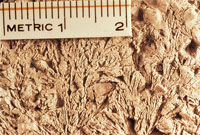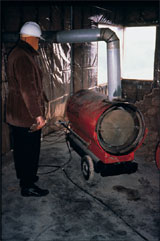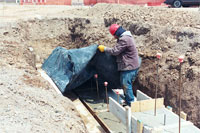How Long Does Concrete Need To Cure Before Freezing?
Weather weather condition at a jobsite – hot or cold, windy or calm, dry or humid – may be vastly dissimilar from the optimum conditions assumed at the fourth dimension a concrete mix is specified, designed, or selected – or from laboratory atmospheric condition in which concrete specimens are stored and tested. Concrete can be placed in cold weather conditions provided acceptable precautions are taken to convalesce the negative impacts of low ambient temperatures. The electric current American Concrete Constitute (ACI) definition of cold-atmospheric condition concreting, as stated in ACI 306 is, "a period when for more than three successive days the average daily air temperature drops beneath 40 degrees Fahrenheit and stays below 50 degrees Fahrenheit for more than half of whatever 24 hour period." This definition tin potentially pb to problems with freezing of the physical at an early historic period.
 All physical must exist protected from freezing until it has reached a minimum strength of 500 pounds per square inch (psi), which typically happens inside the start 24 hours. If physical freezes while it is still fresh or before it has developed sufficient forcefulness to resist the expansive forces associated with the freezing water, ice formation results in the disruption of the cement paste matrix causing an irreparable loss in forcefulness. Early freezing can result in a reduction of up to 50 per centum in the ultimate force. Once physical has attained a compressive strength of around 500 psi, it is generally considered to have sufficient strength to resist significant expansion and damage if frozen. Whenever air temperature at the time of concrete placement is below 40 degrees Fahrenheit and freezing temperatures inside the start 24 hours after placement are expected, the following general issues should exist considered:
All physical must exist protected from freezing until it has reached a minimum strength of 500 pounds per square inch (psi), which typically happens inside the start 24 hours. If physical freezes while it is still fresh or before it has developed sufficient forcefulness to resist the expansive forces associated with the freezing water, ice formation results in the disruption of the cement paste matrix causing an irreparable loss in forcefulness. Early freezing can result in a reduction of up to 50 per centum in the ultimate force. Once physical has attained a compressive strength of around 500 psi, it is generally considered to have sufficient strength to resist significant expansion and damage if frozen. Whenever air temperature at the time of concrete placement is below 40 degrees Fahrenheit and freezing temperatures inside the start 24 hours after placement are expected, the following general issues should exist considered:
Initial concrete temperature as delivered
During common cold weather, it may exist necessary to estrus 1 or more of the concrete materials (h2o and/or aggregates) to provide the proper concrete temperature as delivered. Due to the quantities and heat capacity of cement, using hot cement is not an constructive method in raising the initial concrete temperature.
Protection while the physical is placed, consolidated, and finished
The exposure of physical to cold weather will extend the time required for it to accomplish initial set, which may require finishing crews to exist available for a longer period. Depending on the actual ambient temperature, protection of a concrete placement may require the apply of windbreaks, enclosures, or supplementary heat. It may also be advisable to arrange the concrete mixture constituents for the effect of ambience temperature on setting time. This may require an increase in cement content, the employ of an accelerating chemic admixture, or both.
Windbreaks protect the concrete and structure personnel from bitter winds that cause temperature drops and excessive evaporation. Typically, a summit of vi feet is sufficient. Windbreaks could be taller or shorter depending on predictable air current velocities, ambient temperatures, relative humidity, and physical placement temperatures.
Heated enclosures are very constructive for protecting concrete in cold weather, but are probably the most expensive option. Enclosures tin be fabricated of forest, canvas tarpaulins, or polyethylene. Prefabricated rigid-plastic enclosures are likewise available.
 Three types of heaters are used in cold-weather concrete construction: directly fired, indirect fired, and hydronic systems. To avoid carbonation of fresh concrete surfaces, indirect-fired heaters should be used. If the concrete is not exposed to the heater or exhaust directly, and then a straight-fired heater is suitable. Circumspection should exist taken to ensure that workers are non overexposed to carbon monoxide anytime a heater is used inside an enclosure. Hydronic systems transfer estrus past circulating a glycol/water solution in a closed organisation of pipes or hoses. Typical applications for hydronic systems include thawing and preheating subgrades and heating areas that are too large to be practical for an enclosure.
Three types of heaters are used in cold-weather concrete construction: directly fired, indirect fired, and hydronic systems. To avoid carbonation of fresh concrete surfaces, indirect-fired heaters should be used. If the concrete is not exposed to the heater or exhaust directly, and then a straight-fired heater is suitable. Circumspection should exist taken to ensure that workers are non overexposed to carbon monoxide anytime a heater is used inside an enclosure. Hydronic systems transfer estrus past circulating a glycol/water solution in a closed organisation of pipes or hoses. Typical applications for hydronic systems include thawing and preheating subgrades and heating areas that are too large to be practical for an enclosure.
Curing to produce quality concrete
Curing not only requires adequate moisture, but likewise advisable temperature. The temperature of the concrete as placed should be to a higher place forty degrees Fahrenheit using methods described to a higher place, however the elapsing of heating is dependent on the type of service for the concrete, ranging from ane twenty-four hours for high-early on strength concrete that is not exposed to freeze-thaw events during service to 20 days or more for a concrete chemical element that would carry big loads at an early age. In structures that volition carry large loads at an early age, concrete must exist maintained at a minimum of 50 degrees Fahrenheit to accommodate stripping of forms and shoring and to permit loading of the structure.
In no case should concrete exist immune to freeze during the outset 24 hours after information technology has been placed. Since cement hydration is an exothermic reaction, the concrete mixture produces some heat on its own. Protecting that heat from escaping the system using polyethylene sheeting or insulating blankets may be all that is required for good concrete quality. More astringent temperatures may require supplemental estrus.
 Concrete retained in forms or covered with insulation seldom loses enough moisture at 40 to 55 degrees Fahrenheit) to impair curing. Nonetheless, drying from low winter humidities and heaters used in enclosures is a concern. It is expert practice to go out forms in identify equally long as possible, because they help distribute heat more evenly and help forbid drying of the physical. Live steam wearied into an enclosure around the concrete is an fantabulous method of curing considering it provides both rut and wet. Liquid membrane-forming compounds can also exist used within heated enclosures for early curing of concrete surfaces.
Concrete retained in forms or covered with insulation seldom loses enough moisture at 40 to 55 degrees Fahrenheit) to impair curing. Nonetheless, drying from low winter humidities and heaters used in enclosures is a concern. It is expert practice to go out forms in identify equally long as possible, because they help distribute heat more evenly and help forbid drying of the physical. Live steam wearied into an enclosure around the concrete is an fantabulous method of curing considering it provides both rut and wet. Liquid membrane-forming compounds can also exist used within heated enclosures for early curing of concrete surfaces.
It is also important to prevent rapid cooling of the concrete upon termination of the heating menses. Sudden cooling of the concrete surface while the interior is warm may crusade thermal cracking. Methods for gradual cooling of concrete include loosening the forms while maintaining comprehend with plastic sheeting or insulation, gradual subtract in heating inside an enclosure, or turning off the heat and assuasive the enclosure to slowly equilibrate to ambient temperature. Massive structures may require several days or fifty-fifty weeks of gradual cooling to mitigate the probability of thermal bang-up.
Source: https://www.cement.org/learn/concrete-technology/concrete-construction/cold-weather-concreting
Posted by: mendezsponly46.blogspot.com


0 Response to "How Long Does Concrete Need To Cure Before Freezing?"
Post a Comment